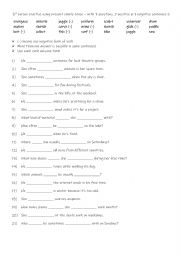
|
3rd person practise using present simple tense � with positive & negative sentences + questions 5
Students familiarise themselves with the 21 verbs. Then they read the sentences to see which question verb is required to complete the gap-fill. Each form is used 7 times! Answers on page 2.
Level: elementary
Age: 8-100
Type:
Downloads: 158
|
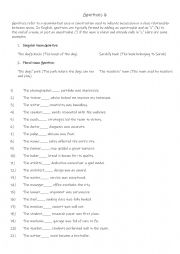
|
A1+-A2 Genitives (6)
This worksheet is suitable for A1+-A2 level students. Genitives refer to a grammatical case or construction used to indicate possession or a close relationship between nouns. Students complete the 20 sentences after reading the rules. Answers on page 2
Level: elementary
Age: 8-100
Type:
Downloads: 131
|

|
A2+-B1 Practise with 12 conditional phrases 4
First, students need to familiarise themselves with the 12 conditional phrases and their meanings and use. Then they read the sentences to see which one is suitable to complete the gap-fill. Each conditional phrase is used 2 times! Answers on page 2.
Level: elementary
Age: 9-100
Type:
Downloads: 131
|
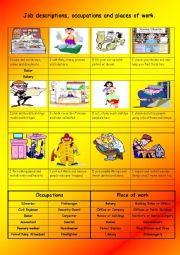
|
Job descriptions, occupations and places of work
Students to read the descriptions then write the occupation and normal place of work using the given vocabulary at the bottom of the page. Part 3 of 4
Level: elementary
Age: 6-12
Type: worksheet
Downloads: 255
|
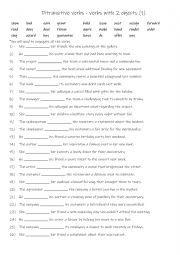
|
B1-B2 Ditransitive verbs - verbs with 2 objects (1)
Learning ditransitive verbs�verbs that take two objects�helps students express complex ideas more naturally in English, especially when describing actions involving both a direct object (the thing being acted upon) and an indirect object (the recipient of the action). For example, in sentences like �She gave him a gift,� �him� is the indirect objec...
Level: intermediate
Age: 9-100
Type:
Downloads: 107
|
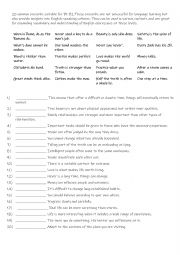
|
Match the proverbs to their meanings
20 common proverbs suitable for B1-B2.These proverbs are not only useful for language learning but also provide insights into English-speaking cultures. They can be used in various contexts and are great for expanding vocabulary and understanding of English expressions at these levels. Answers included on the following page.
Level: advanced
Age: 15-100
Type:
Downloads: 123
|
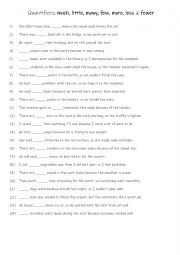
|
A2-B1 Quantifiers - much, little, many, few, more, less & fewer
Students familiarise themselves with the 7 quantifiers and their use and meanings . Then they read the sentences to see which quantifier is needed/ suitable to complete the gap-fill.
Level: elementary
Age: 8-100
Type:
Downloads: 102
|
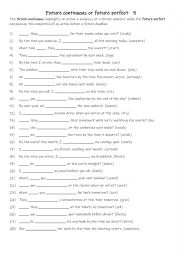
|
A2+-B1 Future continuous or future perfect 5
Understanding these tenses allows students to communicate future goals, schedules, and timelines effectively, enhancing both their speaking and writing skills for academic, professional, and everyday use. First, students need to familiarise themselves with the 2 tenses and their use. Then they read the sentences to work out which tense is needed to...
Level: elementary
Age: 10-100
Type:
Downloads: 143
|
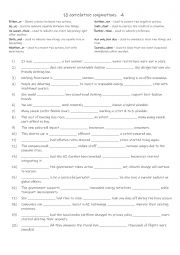
|
B1-B2 10 correlative conjunctions 4
First, students need to familiarise themselves with the 10 conjunctions and their meanings. Then they read the sentences to see which one is required to complete the gap-fill. Each linker is used 2 times! Answers on page 2.
Level: intermediate
Age: 12-100
Type:
Downloads: 135
|

|
14 Time connectors
Students complete the sentences using one of the fourteen connectors.This worksheet is suitable for B1-B2 level students. Answer on page 2
Level: intermediate
Age: 10-100
Type:
Downloads: 112
|












